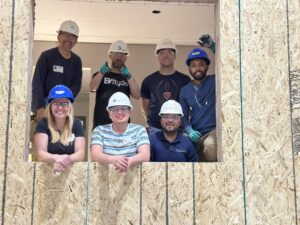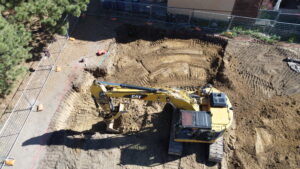Driven Pile Foundations
Driven piles (precast piles) are prefabricated elements (timber, steel, or concrete), which are driven into the ground by percussion, pressing or vibration, using proper machinery. The execution method used for this type of pile is fast and does not depend on local conditions, presenting good stability in soft soils.
|
Advantage |
Disadvantage |
|
Driven piles are relatively easy to install. |
They can be expensive to install. |
|
They can be installed in a variety of soil types. |
The noise generated during installation can be disruptive. |
|
Driven piles offer a high degree of load-bearing capacity. |
There is a risk of damage to underground utilities. |
|
Efficient methods of supporting the construction of a new building. |
The main disadvantage of piles is that they must extend deep into the earth to get adequate support. |
|
Fast installation. |
When piles are not evenly spaced, this unbalance can cause problems for adjacent piles, resulting in additional settlements or bearing failures. |
|
They can be used in areas that have minimal or no ground preparation, as they require no excavation work to install them. |
|
|
Driven piles offer a high degree of load-bearing capacity. |
Micro Pile Foundation
Micro piles, also known as mini piles, pin piles, needle piles, and root piles, are a deep foundation element constructed using high-strength, small-diameter steel casing and/or threaded bars.
The casing, with a diameter generally in the range of 3 to 10 inches is advanced to the design depth using a drilling technique.
Reinforcing steel, typically an all-thread bar, is inserted into the micro pile casing and high-strength cement grout pumped in. The casing may extend to the full depth or end above the bond zone with the reinforcing bar extending to the full depth.
Capacities vary depending on the micro pile size and subsurface profile but compressive capacities of more than 500 tons have been achieved.
|
Advantage |
Disadvantage |
|
Resists compressive, uplift/tension, and lateral loads. |
Low lateral stiffness |
|
Can be installed in restricted access and low headroom sites with minimal disruption to operations. |
High corrosion rate |
|
May avoid utility re-routing. |
|
|
Alleviates quality assurance concerns associated with cast-in-place piling in weak soils. |
|
|
Can be combined with other techniques to meet unique or complex project requirements cost-effectively and efficiently. |
Caisson Foundations
A caisson foundation, also called pier foundation, is a watertight retaining structure used as a bridge pier, in the construction of a concrete dam, or for the repair of ships.
It is a prefabricated hollow box or cylinder sunk into the ground to some desired depth and then filled with concrete thus forming a foundation.
Caisson foundation is Most often used in the construction of bridge piers & other structures that require foundation beneath rivers & other bodies of water. This is because caissons can be floated to the job site and sunk into place.
Caisson foundations are similar in form to pile foundations but are installed using a different method. It is used when soil of adequate bearing strength is found below surface layers of weak materials such as fill or peat. It is a form of deep foundation which is constructed above ground level, then sunk to the required level by excavating or dredging material from within the caisson. Caissons (also sometimes called “piers”) are created by auguring a deep hole into the ground, and then filling it with concrete.
Steel reinforcement is sometimes utilized for a portion of the length of the caisson. Caissons are drilled either to bedrock (called “rock caissons”) or deep into the underlying soil strata if a geotechnical engineer finds the soil suitable to carry the building load. When caissons rest on soil, they are generally “belled” at the bottom to spread the load over a wider area. Special drilling bits are used to remove the soil for these “belled caissons”. The caisson foundations carry the building loads at their lower ends, which are often bell-shaped.
|
Advantage |
Disadvantage |
|
It is very economic. |
It is very sensitive to construction procedures. |
|
It minimizes pile cap needs. |
They are not good for use in contaminated sites. |
|
Working inside a caisson creates less vibration and noise. |
It needs qualified inspectors and construction crew. |
|
Caisson technology is highly flexible and can adapt to most construction needs on site. |
|
|
The caisson foundations have high axial and lateral loading capacity. |
Bored Pile Foundation
Bored pile foundations, also known as replacement piles, are typically poured in place and provide support for structures, transferring their load to layers of soil or rock that have sufficient bearing capacity and suitable settlement characteristics.
|
Advantage |
Disadvantage |
|
Bored piles are easy and quick to install, with minimal disruption to traffic or neighboring structures. The process for installing bored piles relies on machines that are already commonly used on construction sites. All that is required to install one is a suitable base for the pile, which can be excavated quickly using an excavator or backhoe. |
Vibration of soil underneath the area where drilling takes place. If boring is done improperly, it can cause more damage than good such as causing ground slippage, increased settlement or even bedrock collapse which can lead to cracking in surrounding structures such as roads or buildings if not repaired properly afterwards. As long as proper procedures are followed when installing bored piles there should be no issues with settlement once construction is complete, which makes it an attractive option for builders who need to push back soft soil during construction. |
|
Bored Piles also have excellent resistance against corrosion. |
Requires more time than other systems do. |
|
The advantage to this method is that it can be used almost anywhere since it doesn’t require a solid concrete foundation. |
Noise pollution caused by machinery during Drilling. |
|
They can be installed in almost any weather conditions. |
More expensive than other foundation methods |
|
They offer good load-bearing capacity and can be used to support large structures. |
Require skilled equipment and operators. |
|
They help to create the necessary support for a building, and they also provide support against lateral pressure forces. |
Can be disruptive to surrounding ground and buildings if not installed correctly. |
|
Bored piles help stabilize foundations for buildings and other structures by providing lateral resistance against the pressure of soil or water. |
|
|
When compared to solid steel piling, bored piles cost less and provide more flexibility in design options. |
Types of Bored Piles
Drilled Shaft Piles
Drilled shaft piles, also referred to as bored piles, are created by drilling a hole into the ground using specialized drilling equipment, such as a mechanical auger or rotary drilling rig. They can range from 2 to 30 feet in diameter and can be over 300 feet in length. After reaching the desired depth, the hole is typically filled with reinforcement, such as steel bars or cages, and then concrete is poured to form the pile.
Drilled shaft piles are commonly reinforced with steel reinforcement cages, providing additional tensile strength to the pile. The reinforcement enhances the load-bearing capacity and allows the pile to withstand vertical and lateral loads. Drilled shaft piles are commonly reinforced with steel reinforcement cages, providing additional tensile strength to the pile. The reinforcement enhances the load-bearing capacity and allows the pile to withstand vertical and lateral loads.
Auger Cast Piles
Auger cast piles are typically 12 to 24 inches in diameter, but diameters of 36 inches have been used successfully.
Grout strengths usually range from 3,000 to 5,000 psi. Like conventional drilled shafts, auger cast piles can derive resistance from both side friction and end bearing. Allowable vertical axial load capacities typically range from about 40 to 150 tons, depending on the pile size and soil conditions. Auger cast piles are constructed using a continuous flight hollow stem auger that is powered by a drill motor.
Auger cast piles are best suited for sites with soft to medium dense soil conditions. They can be socketed into dense soil or weak rock to achieve higher end bearing, but the amount of embedment into these layers can be limited, since the downward drilling force imposed during drilling is generally limited by the self-weight of the auger and drill motor suspended from the crane. Therefore, these piles may not be appropriate where significant embedment is required into dense soil or rock.
Auger cast piles are commonly used in projects where the focus is on frictional resistance between the pile and the surrounding soil, rather than end-bearing capacity. They are suitable for cohesive soils and some non-cohesive soils.
Ready to learn more?
Deep Foundations, Part One: Intro
Deep Foundations, Part Two: Comparison with Shallow Foundations
Deep Foundations, Part Four: Type Comparisons
Different Structural Foundation Types
Straight Shaft Drilled Concrete Pier Foundation










